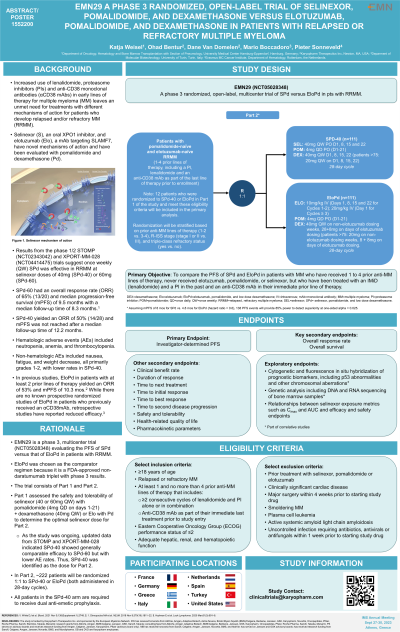Treatment of Relapsed/Refractory Myeloma
Poster Session 2
P-323: A Phase 3 Randomized, Open-label Trial of Selinexor, Pomalidomide, and Dexamethasone Versus Elotuzumab, Pomalidomide, and Dexamethasone in Patients with Relapsed or Refractory Multiple Myeloma
Thursday, September 28, 2023
12:30 PM - 1:30 PM EEST


Katja Weisel, MD (she/her/hers)
Deputy Director
University Medical Center of Hamburg-Eppendorf, Hamburg, Germany
Hamburg, Germany
Introduction: Trial in progress
Increased use of lenalidomide, proteasome inhibitors (PIs) and anti-CD38 monoclonal antibodies (αCD38 mAbs) in early lines of therapy for multiple myeloma (MM) leaves an unmet need for treatments with different mechanisms of action for patients (pts) who develop relapsed and/or refractory MM (RRMM). Selinexor (S), an oral XPO1 inhibitor, and elotuzumab (Elo), a mAb targeting SLAMF7, have novel mechanisms of action and have been evaluated with pomalidomide and dexamethasone (Pd). Results from the phase 1/2 STOMP (NCT02343042) and XPORT-MM-028 (NCT04414475) trials suggest once weekly (QW) SPd was effective in RRMM at S doses of 40mg (SPd-40) or 60mg (SPd-60). SPd-60 had an overall response rate (ORR) of 65% (13/20) and median progression-free survival (mPFS) of 9.5 months (mos). SPd-40 yielded an ORR of 50% (14/28) and mPFS was not reached after a median follow-up time of 12.2 mo. Hematologic adverse events (AEs) included neutropenia, anemia, and thrombocytopenia. Non-hematologic AEs included nausea, fatigue, and weight decrease, all primarily grades 1-2 in severity, with lower rates in SPd-40. In previous studies, EloPd in pts with at least 2 prior lines of therapy yielded an ORR of 53% and mPFS of 10.3 mos. While there are no known prospective randomized studies of EloPd in pts who previously received an aCD38mAb, retrospective studies have reported reduced efficacy.
Methods: Study design: A Phase 3 randomized, open-label, multicenter trial (NCT05028348) of SPd versus EloPd in pts with RRMM. Select eligibility includes 1-4 prior lines of therapy, including lenalidomide, a PI, and treatment with a regimen that included an αCD38 mAb in the immediate prior line of therapy, but naïve to P, S, and Elo. Randomization stratification factors include number of prior lines, Revised International Staging System (R-ISS) stage, and triple-class refractoriness. The primary objective is to compare the PFS of SPd vs EloPd.
The trial consists of two parts. Part 1 assessed the safety and tolerability of S (40 or 60 mg QW) with P (4mg QD on days 1-21) + d (40mg QW) or Elo with Pd to determine the optimal S dose for Part 2. As the study was ongoing, updated data from STOMP and XPORT-MM-028 indicated SPd-40 showed generally comparable efficacy to SPd-60 but with lower AE rates. Thus, SPd-40 was identified as the dose for Part 2. In part 2, ~222 pts will be randomized 1:1 to SPd-40 or EloPd (both administered in 28-day cycles). All pts in the SPd-40 arm will receive dual anti-emetic prophylaxis, such as a 5-HT3 antagonist and olanzapine. Assuming mPFS of 8 mos for SPd vs. 4.8 mos for EloPd (hazard ratio = 0.6), 138 PFS events will provide 85% power to detect superiority at one-sided alpha = 0.025. Secondary endpoints include ORR, overall survival, safety and tolerability, and patient-reported quality of life outcomes. Study treatment may continue until progressive disease and all pts will be followed for survival for 3 years.
Results: N/A
Conclusions: N/A
Increased use of lenalidomide, proteasome inhibitors (PIs) and anti-CD38 monoclonal antibodies (αCD38 mAbs) in early lines of therapy for multiple myeloma (MM) leaves an unmet need for treatments with different mechanisms of action for patients (pts) who develop relapsed and/or refractory MM (RRMM). Selinexor (S), an oral XPO1 inhibitor, and elotuzumab (Elo), a mAb targeting SLAMF7, have novel mechanisms of action and have been evaluated with pomalidomide and dexamethasone (Pd). Results from the phase 1/2 STOMP (NCT02343042) and XPORT-MM-028 (NCT04414475) trials suggest once weekly (QW) SPd was effective in RRMM at S doses of 40mg (SPd-40) or 60mg (SPd-60). SPd-60 had an overall response rate (ORR) of 65% (13/20) and median progression-free survival (mPFS) of 9.5 months (mos). SPd-40 yielded an ORR of 50% (14/28) and mPFS was not reached after a median follow-up time of 12.2 mo. Hematologic adverse events (AEs) included neutropenia, anemia, and thrombocytopenia. Non-hematologic AEs included nausea, fatigue, and weight decrease, all primarily grades 1-2 in severity, with lower rates in SPd-40. In previous studies, EloPd in pts with at least 2 prior lines of therapy yielded an ORR of 53% and mPFS of 10.3 mos. While there are no known prospective randomized studies of EloPd in pts who previously received an aCD38mAb, retrospective studies have reported reduced efficacy.
Methods: Study design: A Phase 3 randomized, open-label, multicenter trial (NCT05028348) of SPd versus EloPd in pts with RRMM. Select eligibility includes 1-4 prior lines of therapy, including lenalidomide, a PI, and treatment with a regimen that included an αCD38 mAb in the immediate prior line of therapy, but naïve to P, S, and Elo. Randomization stratification factors include number of prior lines, Revised International Staging System (R-ISS) stage, and triple-class refractoriness. The primary objective is to compare the PFS of SPd vs EloPd.
The trial consists of two parts. Part 1 assessed the safety and tolerability of S (40 or 60 mg QW) with P (4mg QD on days 1-21) + d (40mg QW) or Elo with Pd to determine the optimal S dose for Part 2. As the study was ongoing, updated data from STOMP and XPORT-MM-028 indicated SPd-40 showed generally comparable efficacy to SPd-60 but with lower AE rates. Thus, SPd-40 was identified as the dose for Part 2. In part 2, ~222 pts will be randomized 1:1 to SPd-40 or EloPd (both administered in 28-day cycles). All pts in the SPd-40 arm will receive dual anti-emetic prophylaxis, such as a 5-HT3 antagonist and olanzapine. Assuming mPFS of 8 mos for SPd vs. 4.8 mos for EloPd (hazard ratio = 0.6), 138 PFS events will provide 85% power to detect superiority at one-sided alpha = 0.025. Secondary endpoints include ORR, overall survival, safety and tolerability, and patient-reported quality of life outcomes. Study treatment may continue until progressive disease and all pts will be followed for survival for 3 years.
Results: N/A
Conclusions: N/A
